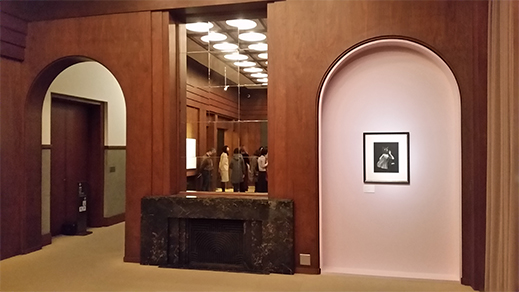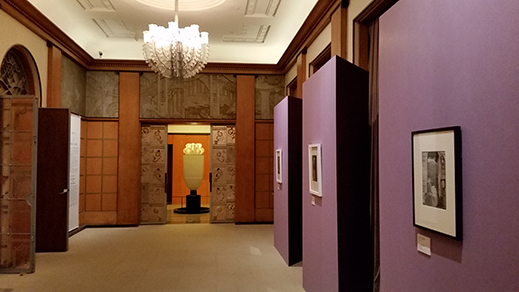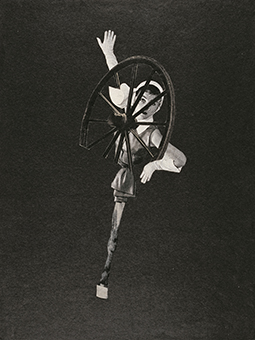 |
Focus features two in-depth reviews each month of fine art, architecture and design exhibitions and events at art museums, galleries and alternative spaces around Japan. The contributors are non-Japanese residents of Japan. |
|
|
 |
 |
 |
The Accidental Surrealist: Toshiko Okanoue
Alice Gordenker |
 |
|
"Fantasy" (c. 1954), private collection |
Toshiko Okanoue burst onto the Tokyo art scene as a young woman in the 1950s when her photo collages came to the attention of Shuzo Takiguchi, a leading figure in Japan's Surrealism movement. Although Okanoue's work features the fantastic imagery and incongruous juxtapositions that characterize Surrealism, the similarities were accidental: at the time, she knew nothing of the international effort to liberate the imagination by tapping the unconscious mind, or indeed that collage was an established medium already used for decades by avant-garde artists in Europe. Okanoue hit upon photo collage as a means of self-expression independently, through her own explorations with scissors, glue and images clipped from imported magazines.
 |
|
 |
|
|
The main building of the Tokyo Metropolitan Teien Art Museum, an Art Deco mansion built in 1933 for a member of the Japanese imperial family, provides a suitably elegant setting for Okanoue's photo collages of images taken from fashion magazines. (Photos by Alice Gordenker) |
A large-scale exhibition currently on view at the Tokyo Metropolitan Teien Art Museum, Toshiko Okanoue, Photo Collage: The Miracle of Silence, presents more than 100 of Okanoue's works. It traces both the development of her style and the arc of her brief but important career, which effectively ended upon her marriage in 1957. For nearly half a century after that, Okanoue was largely forgotten and her imaginative compositions relegated to a trunk in her home. Thankfully, Okanoue was "rediscovered" by influential photo-historian Ryuichi Kaneko, who organized an exhibition of her oeuvre in 2000 at the Daiichi Seimei Minami Gallery. Since then there has been a resurgence of interest. The present exhibition is the largest-ever showing of Okanoue's work in a public museum and makes available important reference materials, including original issues of the magazines in which her photo collages were published.
 |
|
 |
|
|
|
|
"Visit in Night" (c. 1952), collection of the National Museum of Modern Art, Tokyo
|
|
"A Rut" (1951), collection of the Museum of Art, Kochi |
Born in Kochi Prefecture in 1928, Okanoue moved to Tokyo with her family while still a young child. This was a time when Japanese women were increasingly adopting Western-style dress, but because ready-made fashion was prohibitively expensive, it was common for women to make their own clothing. Like many girls of the day, Okanoue learned pattern-making at school and developed a keen eye for Western fashion by studying imported magazines such as Harper's Bazaar and Vogue. In 1950, at the age of 22, Okanoue enrolled in an innovative school named Bunka Gakuin to study design. One of the techniques she explored there was chigiri-e, a traditional Japanese art in which pieces of handmade paper in different colors are torn and combined to create an image. Noticing a cutout of a woman's head among the scraps on the table where she was working, Okanoue was inspired to clip additional images from women's magazines and glue them together in incongruous ways. In her earliest photo collages, the compositions are simple and pasted onto a plain background of red or black.
 |
|
Okanoue clipped images of fashionable men and women from the pages of imported magazines like Harper's Bazaar, Vogue and Life. Examples of her leftover scraps are included in the exhibition. (Photo by Alice Gordenker) |
It was around this time that Okanoue met Takiguchi, who took an interest in her work and mentored her, introducing her, for example, to the collages of Max Ernst. This encounter with the German artist's work inspired Okanoue to shift from simple compositions with single-color backgrounds to more complex collages that used photographs for the backgrounds as well. Takiguchi organized two solo exhibitions for Okanoue, held in 1953 and 1956, at the Takemiya Gallery in Kanda. At the height of her fame, her collages were frequently featured in art and photography magazines in Japan, including Asahi Club, Bijutsu Techo and Camera, as well as in international publications.
Okanoue's wartime experiences, which included witnessing the immediate aftermath of the massive air raids on Tokyo in May 1945, are reflected in the many scenes of catastrophe that appear in her work. Women are often shown without their heads, or with their heads replaced by inanimate objects such as fans, pitchers and propellers.
 |
|
"Meeting" (1955), collection of the Museum of Fine Arts, Houston
|
By the latter half of the 1950s, Okanoue sensed that she had reached the limit of what she could do with collage and began to use a camera to take her own photographs. Her second solo exhibition at Takemiya Gallery included photographs as well as collages, but she did not continue long with photography. Later, while raising children, Okanoue began to sketch and to learn Nihonga painting. Although a few examples of this work are included in the exhibition, they are clearly personal explorations rather than finished pieces. It would be interesting to see what Okanoue might have produced in these and other media had she decided to continue a career in the public eye.
The exhibition catalog, which was produced by Seigensha Art Publishing, includes an essay by organizing curator Kyoko Jimbo and poetry by Okanoue, who is now 91 and living in Kochi. The catalog does not have English translation.
 |
|
The exhibition includes examples of the postwar fashion featured in the magazines Okanoue used as her raw materials. Left, evening gown by Christian Dior, c. 1952, and right, evening dress of black velvet over white silk tulle by Cristobal Balenciaga, 1951. Both are from the collection of the Kyoto Costume Institute. (Photo by Alice Gordenker)
|
All works © Okanoue Toshiko; images courtesy of the Tokyo Metropolitan Teien Art Museum except where otherwise noted. |
 |
 |
Alice Gordenker
Alice Gordenker is a writer and translator based in Tokyo, where she has lived for more than 20 years. For over a decade, she penned the "So, What the Heck Is That?" column for The Japan Times, providing in-depth reports on everything from industrial safety to traditional talismans. She translates and consults for museums, and has a special interest in making Japanese museums more accessible for visitors from other countries. |
|
 |
|